
Accursed rings! Hammer-mad Japanese! Arms-manufacturing Baronesses! Welcome to Zelda.
Somewhere in Los Angeles there‘s a burglar who‘s made off with more than he‘s bargained for”¦a maharajah‘s curse. Somebody stole into the Zelda Apartments in March of 1941 and there into the room of Mrs. F. S. Tintoff, making off with a 400 year-old ring that held two large stones, a ruby and an emerald, surrounded by small diamonds.

“It was given to me by my husband, a jeweler, who purchased it from a maharajah. The ring formerly adorned an East India princess, and was supposed to have been given a mysterious Oriental curse which would bring death to the person who stole it,” said Mrs. Tintoff. The burglar took other jewelry which with the ring had a value of $560 ($8,196 USD2007), and two other tenants in the apartment building reported similartly burgled jewelry losses to police, but nothing thereof with a curse upon‘t. The Tintoff ring thus joins other bloodstained jewels of the East, like the Dehli Purple Sapphire, the stolen-from-the-Eye-of-Sita Hope Diamond and the similarly snatched Black Orlov. And that deadly ring of Valentino.
Did our housebreaker lose this cursed thing to the ages as he writhed in some forlorn torment somewhere? Were his last days exactly like this? Or perhaps the curse was purely legalistic.
What, or who, is Zelda? Zelda La Chat (née Keil) was born in 1870, arriving in Los Angeles some time in the 90s. She builds the eponymous Zelda, a modest bargeboard affair at the southwest corner of Fourth and Grand, here, about 1904:

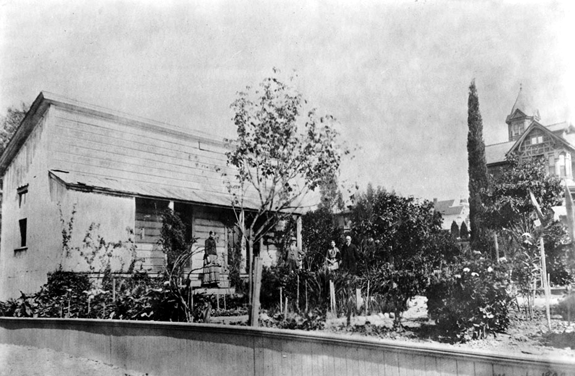
 …which suffices only until she can fashion a thirty-nine unit brick apartment complex in 1908. She lives therein until she dies of cerebral hemorrhage in 1926; she leaves an estate valued at $300,000 ($3,521,554 USD2007).
…which suffices only until she can fashion a thirty-nine unit brick apartment complex in 1908. She lives therein until she dies of cerebral hemorrhage in 1926; she leaves an estate valued at $300,000 ($3,521,554 USD2007).

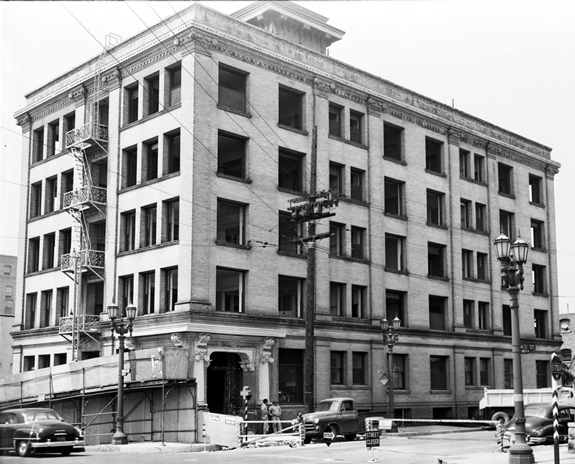
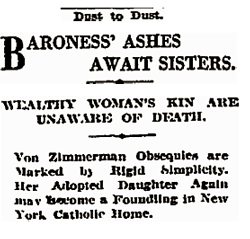 Zelda wasn‘t the only wealthy woman to die in the Zelda–Baroness Rosa von Zimmerman, who with her husband the Baron were second only to Krupps when to it came to weapons manufacturing for various Teutonic scraps, lived at the Zelda and died there, an alien enemy, in 1917, leaving Rosamond Castle, on fourteen acres, across from the Huntington Hotel; eleven acres in Beverly Hills; and thirty-four acres in the Palisades near Santa Monica; and about $2.5million in mortgages, bonds and securities. Nine year-old Beatrice Denton, to whom Baroness von Zimmerman was benefactress, was supposed to be a beneficiary of the estate, but the Baroness never got around to those formalities. Foundling Beatrice became once again an orphan and was likely returned to the asylum from which she was plucked.
Zelda wasn‘t the only wealthy woman to die in the Zelda–Baroness Rosa von Zimmerman, who with her husband the Baron were second only to Krupps when to it came to weapons manufacturing for various Teutonic scraps, lived at the Zelda and died there, an alien enemy, in 1917, leaving Rosamond Castle, on fourteen acres, across from the Huntington Hotel; eleven acres in Beverly Hills; and thirty-four acres in the Palisades near Santa Monica; and about $2.5million in mortgages, bonds and securities. Nine year-old Beatrice Denton, to whom Baroness von Zimmerman was benefactress, was supposed to be a beneficiary of the estate, but the Baroness never got around to those formalities. Foundling Beatrice became once again an orphan and was likely returned to the asylum from which she was plucked.
 Yes, there’s never a lack of excitement at the Zelda. Take by example the May 1916 discharge of Zelda‘s porter George “an erratic Japanese” Nakamoto. Having been sacked by La Chat, and replaced by one K. Kitagawa, Nakamoto saw fit to return to the Zelda to seek out his successor. There was Kitagawa, crouched low, tacking down oilcloth in a cubbyhole beneath a stairway; Nakamoto grabbed a riveting hammer and struck him repeatedly on the head, injuring his skull, and sending him to Receiving hospital in critical condition.
Yes, there’s never a lack of excitement at the Zelda. Take by example the May 1916 discharge of Zelda‘s porter George “an erratic Japanese” Nakamoto. Having been sacked by La Chat, and replaced by one K. Kitagawa, Nakamoto saw fit to return to the Zelda to seek out his successor. There was Kitagawa, crouched low, tacking down oilcloth in a cubbyhole beneath a stairway; Nakamoto grabbed a riveting hammer and struck him repeatedly on the head, injuring his skull, and sending him to Receiving hospital in critical condition.
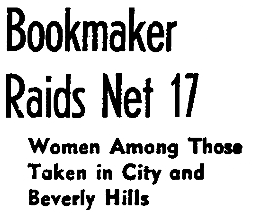 And then there was the night of March 10, 1939, when vice squads in Los Angeles in Beverly Hills came down on bookmaking establishments; seventeen were arrested, including James Adams, 48; George Taylor, 24; James Roberts, 26; Mrs. Agnes Meyers, 36, and Yvonne Lucas, 21, whom Central Vice took offense to the making of book in an apartment at the Zelda. (Interestingly, across Hollywood and Beverly Hills, the pinched bookmakers more often than not had names like Murray Oxhorn and Morris Levine and Saul Abrams and Joseph Blumenthal; could our Zelda perchance have been a bit”¦restricted?)
And then there was the night of March 10, 1939, when vice squads in Los Angeles in Beverly Hills came down on bookmaking establishments; seventeen were arrested, including James Adams, 48; George Taylor, 24; James Roberts, 26; Mrs. Agnes Meyers, 36, and Yvonne Lucas, 21, whom Central Vice took offense to the making of book in an apartment at the Zelda. (Interestingly, across Hollywood and Beverly Hills, the pinched bookmakers more often than not had names like Murray Oxhorn and Morris Levine and Saul Abrams and Joseph Blumenthal; could our Zelda perchance have been a bit”¦restricted?)
Postwar Zelda was full of fun too. Joseph M. Marcelino, 21, was just another ex-Marine who worked in a box factory. When he got nabbed on October 4, 1950, while burglarizing an apartment in the Gordon at 618 West 4th, he copped to having set fire to the Zelda, aflame at that very moment. He admitted as well to torching another hotel at 322 South Spring. He was freed without bail pending a psychiatric examination. But come April, when he broke into a factory at 1013 Santa Barbara Ave. and stole company checks, which he made payable to himself and cashed, the police came knocking.
 Marcelino had also attempted to lift a safe and had lost part of his fingernail in the process–the cops found they had the perfect match.
Marcelino had also attempted to lift a safe and had lost part of his fingernail in the process–the cops found they had the perfect match.
But the winds of change blew foul in 1954. Sure, people waved their arms and preached the evils of gingerbread ornament and its relationship to tuberculosis, but when you came right down to it, The Hill impeded traffic flow. A new project, known as the 4th Street Cut, began that Summer, involving a 687-foot viaduct shooting eastward from the Harbor Freeway, carrying four lanes of one-way traffic above Figureora and Flower, then biting into the hill and passing beneath bridges at Hope and Grand before dipping down into the business district. Through the early 1950s there was much controversy over this plan–proponents of a tunnel argued that a cut would “hopelessly bisect” Bunker Hill. What they didn‘t realize was that soon enough, there‘d be no Bunker Hill to bisect.

Fourth Street, in becoming a cut, and Grand, in becoming a bridge, meant one thing: the surrounding buildings would have to go. And so they did. The Zelda was razed in August of 1954:
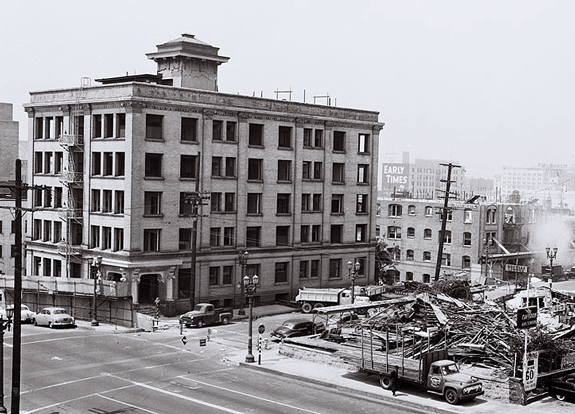
Seen being demo‘d next to the Zelda is the Gordon at 618 West 4th (you remember, the place Marcelino was nabbed in in ‘50); the Gordon, the Bronx at 624 and the La Belle at 630 West 4th were all torn down to make way for the Cut–a trio built by the sons of Dr. John C. Zahn.
All this brought a twinge of regret to Percy Howell, the veteran city appraiser who spent two years tramping the Hill, working out fair payments for displaced property owners. Howell remembered his young bachelor days on Bunker Hill back in 1909, when he moved into the Zelda, “batching it” with three other gay blades. “I never dreamed then,” said Howell, “that I would live to see the day when I condemned the Zelda for the city.”
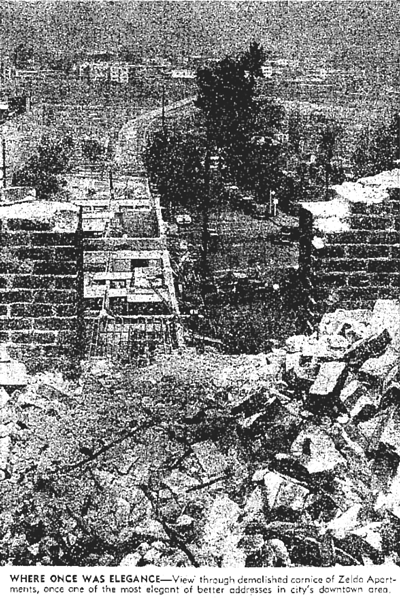
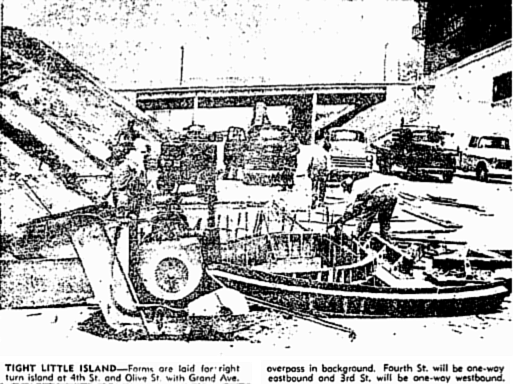
The 4th Street Cut opened May 1, 1956.
A new an improved 4th St., looking east ca. 1964, foundation excavation for the Union Bank in the foreground:
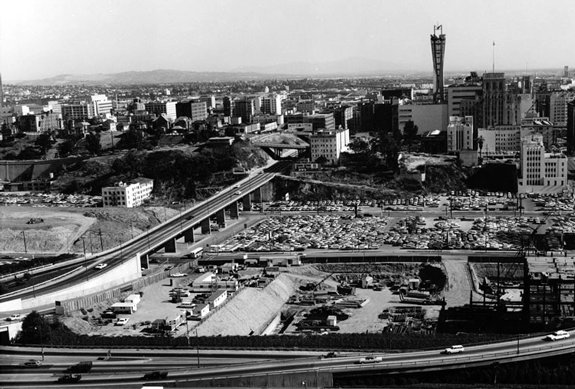
Another shot of the viaduct (I know, why-a no chicken?) ca. 1973, during erection of Security Pacific Plaza.
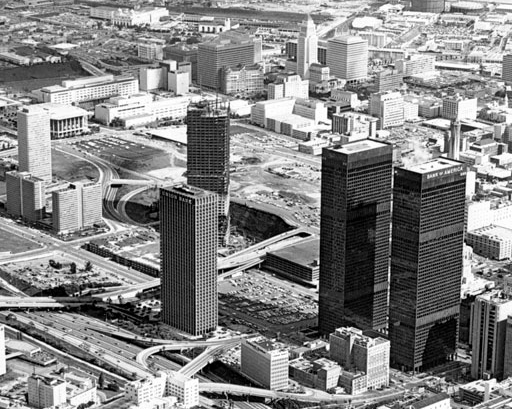
For twenty-five years after Zelda‘s demolition, nothing could stem the march of progress:
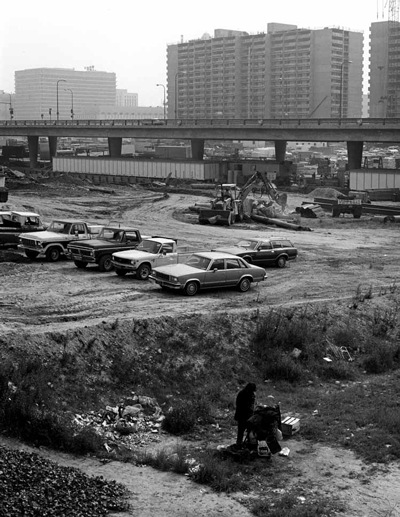
It has filled in now, to be fair.
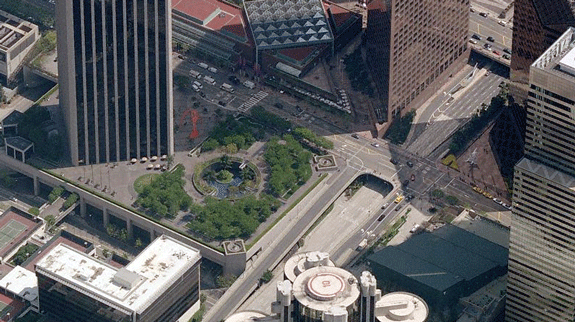
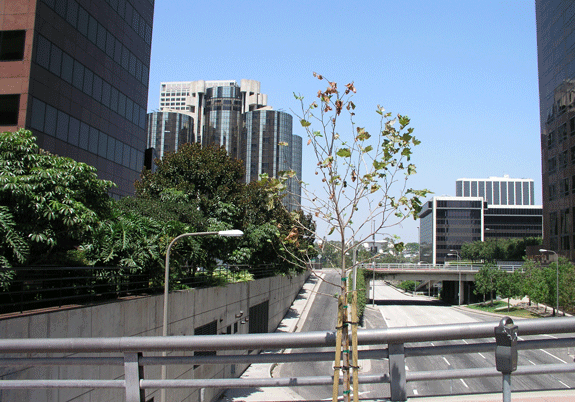
And so goes Zelda La Chat, her Zelda, and 4th Street, though all we have to show for the former glory of 401 South Grand is the pointy backside of 400 South Hope.

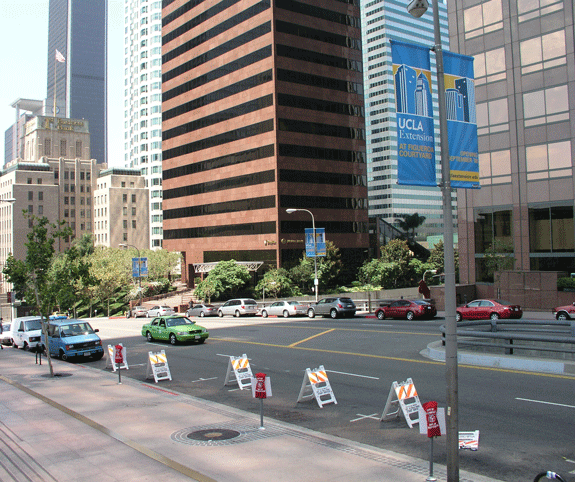
Photographs courtesy USC Digital Archive


OBH reader Carol kindly pointed out to us that Edith Claire Posener, aka Edith Spare (who in 1923 was to become Edith Head) moved into the Zelda ca. 1914. Seems her father’s work as a mining engineer took the family from their New York comforts to rough Mexican camp-towns where Edith and mother Anna would cook for the miners—until at last mama said enough is enough, packed up Edith and they moved in with mama’s friend Mittie Morgan, who lived at the Zelda. According to David Chierichetti’s book on Head, there was a ballroom on the fourth floor of the Zelda and after Edith enrolled in Los Angeles High School (then at the corner of Sunset and Grand) she invited the school over to use it for a dance.
Edith graduated in 1917 and enrolled in Berkeley; when she returned to Los Angeles in 1920, she moved back in with Mittie who had built a home in the Westlake District.
Some might challenge my (granted, seemingly fatuous) remark about the Zelda being a restricted establishment in that Edith was the issue of Anna Levy and Max Posener; but remember, after Anna married Frank Spare, Edith at an early age took on her adopted Catholicism with vigor.
See the Mission-style white building, upper left? That’s the Granada. Zelda was her neighbor. Behind that date palm there.
Notice the lonely steps at the bottom of this image. Those of course led one once through the doors of the Fremont.
From the USC Digital Archives
I was 9 years old when the Zelda was torn down as part of the 4th Street Cut. In those days I spent a lot of time walking around Bunker Hill. One Saturday when the Zelda had been abandoned during the demolition and looked like it does in these pictures, I was curious and went poking around the building. It is amazing to me now that there was no one to see to it that a 9 year old couldn’t get into the site. I am ashamed now to say that I threw rocks through a couple of windows. I do remember feeling saddness at losing this part of the Hill. Just a foretaste of what was to come.
Gordon Pattison, aka Castle Dweller
Beatrice Danton, the child taken in by Baroness Rosa Von Zimmerman was in fact NOT returned to the New York Foundling Home. Custody was granted to her governess, Mary Ardis Schnebly. There was a court fight over money for Beatrice and she wound up with $15,000, quite a bit shy of the $50,000 that they were looking for. Beatrice married and had a family and lived the rest of her life in California